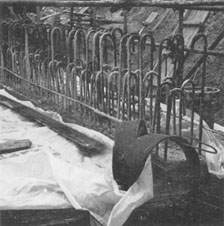
 |
Back to start |
The month's achievement was impressive: 50 cubic yards of site "blinding" were laid, generally to within ½ in. of where it should be, the whole centre floor of the pool had been put down, the base of the shallow-end wall had been cast, and the site was ready for the steel shuttering to build the rest of the surrounding walls. The fourth week was spent in laying the first two sections of the "kicker" the bottom six inches of the wall cast integrally with three to five feet at the edges of the floor. This is the most heavily reinforced part of the pool, having in the deep end a ¾" steel bar every two inches along its whole length. At this point the walls themselves are 15 in. thick at their base. Enquiries on other pools had warned us of the difficulty of casting the 300 slope to the diving pit. If the concrete is too wet it may settle towards the bottom; if it is too dry, it may be impossible to compact into a dense waterproof layer. On a single day, six hours' hard work saw the laying of the entire main slope, twelve cubic yards of concrete in all. All this was managed in spite of a late start to the work. Hand trimming of the hole lasted a fortnight into the work camp; bad weather had made it impossible either to walk on the bottom without losing one's Wellingtons, or to throw a shovel of earth, since it just stuck to the shovel. But when the Summer term and the next stage of the work began, the first 50 cu. yds. of concrete were in position, reinforced by 1,341 bars of three-quarter inch steel, 1,328 of half inch steel and 218 of three-eighths inch steel, all of it bent by hand.
The original hopes of completing the shell of the pool during the Summer term had clearly been pitched too high: such a speed of building would in fact have been rather faster than that reached by the contractors building the new Cambridge City pool of about the same size. The actual achievement during one term was extremely satisfactory, especially considering the problem of instructing and controlling a variable labour force of well over a hundred children. A residential work camp was held during the first week of the Summer holidays, when some of the deep-end wall was cast; after this, work was in abeyance until a second work camp was held just before the new term began.
A project like this could hardly be carried through with no mistakes at all; the only serious one occurred during this term, when the Construction Engineer came over from Cambridge one evening to find that a number of small contributory factors had combined to result in a patch of very poor concrete - a load of over-dry "ready mix", an unhelpful lorry driver, a hot afternoon so that the concrete "went off" quickly, a gang not being absolutely ready to shoot the concrete into precisely the right place. He had to spend two days helping with a pair of large pneumatic drills in breaking out some three cubic yards of concrete on a slope of 300 to the horizontal, prising it out from amongst ¾ bars at 4 in. centres. (It was at this stage that a group of children from the Montessori class helped extract the broken pieces from between the reinforcing bars.) The driver of the compressor for the drills, observing a handful of adults with a gang of children using heavy roadbreakers, was frankly puzzled; he finally hit on the only satisfactory explanation - it must be an Approved School. But he left the site still at a loss to know how to account for the girls.

|
P.V.C. water-bar and steel re-inforcement in a "kicker" section. |
| Back to previous. | Continue to next page. |
| Back to start | |